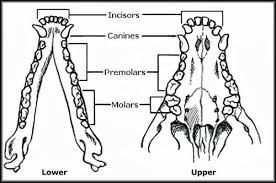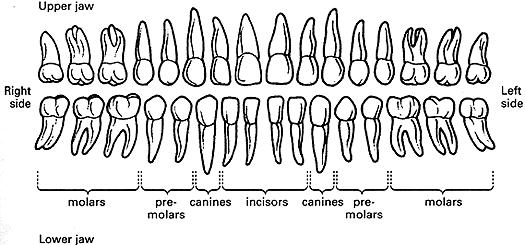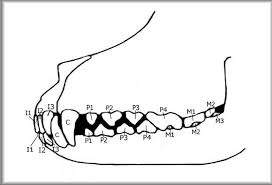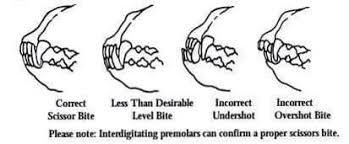

Dogs have two (2) sets of teeth, a deciduous set of twenty eight (28) teeth, which appear around three to four weeks of age and are replaced progressively from approximately four months of age. A full complement of forty two (42) teeth should be realized by six (6) months of age.
DECIDUOUS TEETH
There are twenty eight (28) puppy or deciduous teeth, fourteen (14) in the upper jaw and fourteen (14) in the lower jaw.
|
Deciduous teeth |
I 6+6. C 2+2. PM 6+6 Combined total = 28 |
Puppies do not have any molars or premolar 1.
I = Incisors C = Canine PM = Pre molar
PERMANENT TEETH
Adult dogs have forty two (42) permanent teeth. There are twenty teeth in the upper jaw and twenty-two (22) teeth in the lower jaw. The teeth are categorized into four groups; incisors, canines, premolars and molars. To understand the importance of the teeth it is necessary to understand the purpose of each set of teeth.



 Showing correct alignment of teeth
Showing correct alignment of teeth
Incisors
These teeth are for cutting, nibbling food and grooming, these are the teeth situated directly between the canines.
There are six incisors in both the upper and lower jaw.
The two middle incisors are usually a little smaller than the rest; the incisors generally get larger as they move away from the center.
Eruption
usually occurs between Three (3) and Five (5) months of age
Canines
Primarily for puncturing, and holding, slashing and tearing when fighting, these are the large fangs, the lower canines lock in position in front of the upper canines.
There are two canines in both the upper and lower jaw
Eruption usually occurs between Five
(5) and Six (6) months of age
Premolars
Used for cutting, holding, shearing and breaking food into small pieces. Puppies do not have P1 teeth. Adults have eight (8) premolars in the upper jaw and eight (8) in the lower jaw, four (4) on each side. The premolars vary in size from the smallest (P1) to the largest (P4 upper) apart from the P1 they have a serrated crown.
Eruption
usually occurs between Five (5) and Seven (7) months of age
Molars
Crushing and grinding food into small pieces with flat occlusal tables. Adults have four (4) molars in the upper jaw, two (2) on each side and six (6) in the lower jaw three (3) on each side. The molar 1 of the lower jaw is the largest tooth while molar 3 of the lower jaw is one of the smallest. Molars have crowns that are flat with transverse grooves making them ideal for grinding and crushing.
Eruption usually occurs between Five (5) and Six (6) months of age
Scissor Bite
The incisors must fit
scissor-like to each other so that the incisors of the upper jaw overlap those
of the lower jaw in a scissor fashion. The
condition of an overshot mouth is deemed to occur when the incisors of the
upper jaw protrude a distance of two (2) mm or more from the incisors of the
lower jaw.
Dentition Faults
The most common of faults is missing or additional premolar 1 in either the upper or lower jaw, it has not been scientifically proven that these are linked hereditarily, however, there are clear bloodline connections which link these faults. While additional P1 teeth are undesirable they should not be penalized in the show ring.
Bite faults are common and are more
prevalent in animals with refined, elongated and narrow muzzles. Again these can be bloodline related and are
becoming entrenched within the breed.
Underdeveloped P2’s and P3’s predominantly in the upper jaw are becoming increasingly prevalent within the German Shepherd breed. Greater emphasis in correcting this problem needs to be addressed by ALL stakeholders.

Level
Bite
When the tips of all incisors touch the
tips of each other incisors when the mouth is closed.
This will invariably lead to worn incisors
at a relatively young age approximately four to five years.
A very close or tight scissor bite will also lead to worn incisors.
Overshot
Bite
The lower jaw is short, the lower incisors
do not touch the back of the upper incisors.
This can impair the dog’s ability to cut food, and along with the incorrect placement of the canines may cause health related issues in the mouth.
The condition of an overshot mouth is deemed to occur when the
incisors of the upper jaw protrude a distance of two (2) mm or more from the
incisors of the lower jaw.
Undershot
Bite
Very rare in the German Shepherd breed. The lower jaw is overlong, that is the incisors of the lower jaw protrude in front of the incisors of the upper jaw.
last modified: 7:16pm Sunday the 17th of March, 2019